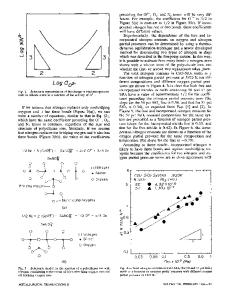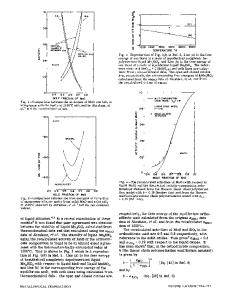Nitrogen solubility in CaO-CaF 2 -SiO 2 melts
- PDF / 452,624 Bytes
- 5 Pages / 603.28 x 783.28 pts Page_size
- 101 Downloads / 319 Views
I.
INTRODUCTION
II.
S I N C E CaF2 is used as a fluxing component to industrial slags in metallurgical processes, some efforts have been made to unveil the role of CaF2 from structural viewpoints, [1,2,3] providing useful information to understand the effects of CaF2 on the refining properties of slags. Nitrogen in CaO-CaF2 melts has been shown to behave as a simple free ion, CaF2 being a mere diluent. [4] However, when a network former is contained in a melt, two nitrogen dissolution mechanisms hold, one as free nitride and the other as incorporated nitride. [5] For the CaO-CaF2-SiO2 system in the present study, it is presumed that reactions between silicates and fluoride lead to the formation of fluorosilicates which was originally proposed by Masson and Caley, [11 as Eq. [1] describes: O=
O-
I
I
O---Si--O--Si--O-
I
1
O-
O-
A thermodynamic equilibration technique has been used as described elsewhere, t41 All of the experiments were conducted at carbon saturation by using graphite crucibles (10-mm OD, 8 - m m ID, 50-mm height) and CO-N2 or CO-Ar-N2 gas mixtures. Chemical analyses of total, free, and incorporated nitrides were carded out using the Kjeldahl method, by which the C N - content is not detected as it is lost during the dissolution of the sample in the acid. For the same reason as described in the preceding paper, tSl the discussion is limited to nitride in this paper. Optimal conditions for the separation of free and incorporated nitrides were found to be a selective dissolution of a slag sample for 6 to 8 hours at 343 to 353 K into a 7 vol pct acetic acid solution into which only free nitride dissolves, tS]
III. + 2F-
EXPERIMENTAL
RESULTS AND DISCUSSION
A. Nitrogen Solubilities along the 1573 K Liquidus Line
If the reactions such as Eq. [ 1] take place, there are various possibilities for their influence on the dissolution of free and incorporated nitride, both from structural and thermodynamic points of view. The purpose of this study is to understand this influence through studying the dependence of nitrogen solubility on slag composition by the separate determination of free and incorporated nitrides.
Our understanding of nitrogen dissolution in multicomponent slags has been greatly advanced by considering the two basic species of nitrogen in slags as proposed in" the precedm'gppea r, [5] n a m e 1y, free and2"mcorporated3 nitrides. In the case of CaO-CaF2, only O - and N - as free ions are considered, whereas in the case o f silicate melts containing CaF2, the presence of F - ions has to be taken into consideration, particularly when the SiO2 content is high. The total nitrogen contents of the CaO-CaF2SiO2 system at P02 = 4.4 • 10 -13 Pa and PN2 = 1.0 • 104 Pa along the 1573 K liquidus line are demonstrated in Figure 1 as a function of CaO content. The slag compositions in Figure 1 are illustrated in Figure 2. The change in total nitrogen content with increasing CaO content is summarized as follows:
ELOY MARTINEZ R., formerly Graduate Student, Department of Metallurgy, The Univer
Data Loading...











